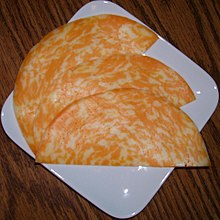Marble cheese: Difference between revisions
Appearance
Content deleted Content added
m small edits Tag: Reverted |
Corrected the common 'England = UK' error and changed the punctuation to avoid the impression that Colby-Jack is British. |
||
| (2 intermediate revisions by 2 users not shown) | |||
| Line 1: | Line 1: | ||
{{Short description|Cheese type characterized by streaks of different colors}} |
|||
[[File:CoJack.jpg|thumb|[[Colby-Jack]], a common type of marbled cheese]] |
[[File:CoJack.jpg|thumb|[[Colby-Jack]], a common type of marbled cheese]] |
||
'''Marble cheese''' is a name given to [[cheese]]s with marbled patterns. These are produced by combining either two different colored [[curd]]s, [[cheese curd]]s or [[processed cheese]]s |
'''Marble cheese''' is a name given to [[cheese]]s with marbled patterns. These are produced by combining either two different colored [[curd]]s, [[cheese curd]]s or [[processed cheese]]s. |
||
==Description== |
==Description== |
||
Marble |
Marble cheeses originate from the UK.<ref name="cheese.com">{{cite web|url=http://www.cheese.com/marbled-cheeses/ |title=Marbled Cheeses |publisher=Cheese.com |date= |accessdate=2015-04-16}}</ref> They are usually [[hard cheese|hard]], [[processed cheese|processed]] cow's milk cheeses. Colby-Jack which combines [[Colby cheese]] and [[Monterey Jack]] is most popular in the [[United States]].<ref name="cheese.com"/> |
||
Others are produced from a combination of the curds of white and orange [[Cheddar cheese|cheddars]] (for ''Marbled Cheddar''), or similar.<ref name="cheese.com"/><ref name="Cheddar">{{cite web|url=http://www.cheese.com/marble-cheddar/ |title=Marble Cheddar |publisher=Cheese.com |date= |accessdate=2015-04-16}}</ref> The marbling is usually not achieved with artificial additives, though cheeses such as [[Red Windsor]] and [[Sage Derby]] may contain colourings such as [[Chlorophyll]] (E140) and [[Carmine]] (E120).<ref name="Practice">{{cite book|last1=Scott|first1=R|last2=Robinson|first2=Richard K.|last3=Wilbey|first3=R. Andrew |title=Cheesemaking Practice|url=https://books.google.com/books?id=NEItzh7YTqAC&pg=PA104 |accessdate=16 April 2015|date=30 September 1998|publisher=[[Springer Science+Business Media]] |isbn=978-0-7514-0417-3 |page=104}}</ref><ref name="Harbutt">{{cite book|last=Harbutt|first=Juliet |title=Cheese|url=https://books.google.com/books?id=ZLIxHey_OGcC&pg=PA170|accessdate=16 April 2015|year=1999|publisher=Willow Creek Press|isbn=978-1-57223-200-6|page=170}}</ref> |
Others are produced from a combination of the curds of white and orange [[Cheddar cheese|cheddars]] (for ''Marbled Cheddar''), or similar.<ref name="cheese.com"/><ref name="Cheddar">{{cite web|url=http://www.cheese.com/marble-cheddar/ |title=Marble Cheddar |publisher=Cheese.com |date= |accessdate=2015-04-16}}</ref> The marbling is usually not achieved with artificial additives, though cheeses such as [[Red Windsor]] and [[Sage Derby]] may contain colourings such as [[Chlorophyll]] (E140) and [[Carmine]] (E120).<ref name="Practice">{{cite book|last1=Scott|first1=R|last2=Robinson|first2=Richard K.|last3=Wilbey|first3=R. Andrew |title=Cheesemaking Practice|url=https://books.google.com/books?id=NEItzh7YTqAC&pg=PA104 |accessdate=16 April 2015|date=30 September 1998|publisher=[[Springer Science+Business Media]] |isbn=978-0-7514-0417-3 |page=104}}</ref><ref name="Harbutt">{{cite book|last=Harbutt|first=Juliet |title=Cheese|url=https://books.google.com/books?id=ZLIxHey_OGcC&pg=PA170|accessdate=16 April 2015|year=1999|publisher=Willow Creek Press|isbn=978-1-57223-200-6|page=170}}</ref> |
||
Latest revision as of 18:46, 3 April 2023

Marble cheese is a name given to cheeses with marbled patterns. These are produced by combining either two different colored curds, cheese curds or processed cheeses.
Description
[edit]Marble cheeses originate from the UK.[1] They are usually hard, processed cow's milk cheeses. Colby-Jack which combines Colby cheese and Monterey Jack is most popular in the United States.[1]
Others are produced from a combination of the curds of white and orange cheddars (for Marbled Cheddar), or similar.[1][2] The marbling is usually not achieved with artificial additives, though cheeses such as Red Windsor and Sage Derby may contain colourings such as Chlorophyll (E140) and Carmine (E120).[3][4]
Types
[edit]- Marble cheddar, a blend of white and orange cheddar.[2]
- Colby-Jack, a blend of Colby cheese and Monterey Jack.[1]
- Red Windsor, cheddar cheese with added red wine (usually Port or Bordeaux), or with a red food colouring.[3][5]
- Sage Derby, a Derby cheese traditionally made with added sage; now usually made using green plants such as spinach, parsley and marigold; or with green vegetable dye.[3][4]
See also
[edit]References
[edit]- ^ a b c d "Marbled Cheeses". Cheese.com. Retrieved 2015-04-16.
- ^ a b "Marble Cheddar". Cheese.com. Retrieved 2015-04-16.
- ^ a b c Scott, R; Robinson, Richard K.; Wilbey, R. Andrew (30 September 1998). Cheesemaking Practice. Springer Science+Business Media. p. 104. ISBN 978-0-7514-0417-3. Retrieved 16 April 2015.
- ^ a b Harbutt, Juliet (1999). Cheese. Willow Creek Press. p. 170. ISBN 978-1-57223-200-6. Retrieved 16 April 2015.
- ^ Jamie Frater, ed. (November 2009). "Top 10 cheeses you should try". The Ultimate Book of Top 10 Lists: The Best of Listverse.com. Ulysses Press. pp. 161–162. ISBN 978-1-56975-715-4. LCCN 2011275306. OCLC 318422338. Retrieved 17 April 2015.
